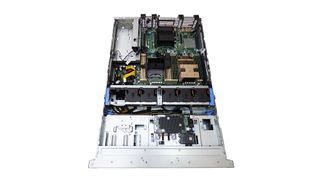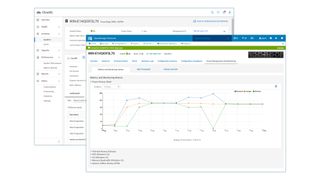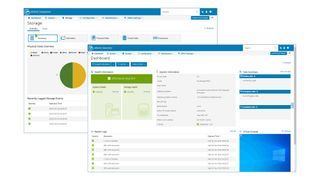IT Pro Verdict
Pros
- +
Great value
- +
Good storage capacity
- +
High expansion potential
- +
Xeon Scalable CPUs
- +
Wealth of remote management services
Cons
Dell EMC’s PowerEdge R550 is aimed squarely at SMBs that have processing power, storage capacity and expansion potential on their shopping list and a tight grip on the purse strings. This 2U rack server looks to deliver on all counts; along with support for dual Xeon Scalable CPUs, it offers a good range of storage features plus plenty of room to grow, and yet doesn’t cost much more that an equivalent 1U model.
It bears a number of similarities to the 1U PowerEdge R450 as it too is offered with a choice of seven Xeon Scalable Gen 3 CPUs. It has the same maximum 165W TDP thermal restriction but this still allows it to support up to 24-core Xeon Scalable Gold 5318Y CPUs - our system was supplied with one of these in residence.
Businesses with storage-centric workloads will find plenty to like here. The R550 supports SAS3 and SATA devices and has room up front for 8 LFF HDDs or 16 SSF HDDs and SSDs, and with 20TB SATA HDDs already available from Dell EMC, the R550 can present a very usable maximum capacity of 160TB.
Dell EMC PowerEdge R550 review: Internal design
The R550 presents a well-designed interior with easy access to all key components for upgrade and maintenance operations. Unlike Dell EMC’s higher-end rack servers such as the R650 and R750, it doesn’t have a T-shaped motherboard and keeps its pair of PSU bays over on the left side.
Entry-level systems can get away with dual 600W redundant PSU but stepping up to dual Gold CPUs will require 800W models. Dell EMC also offers 1,100W versions, although we can’t see many specifications requiring these – especially as the R550 doesn’t support GPU cards.

Cooling is handled efficiently by five hot-plug fans arranged in a removable tray in front of the motherboard. With one CPU in residence, we only needed the standard single rotor variety, whereas dual CPUs will require the high-performance Silver-Grade fan modules fitted.
Our Gold CPU was covered by a sturdy finned passive heatsink and the two sockets are partnered by 16 DIMM slots, with the price for our system including 128GB of memory spread across eight 16GB modules. The maximum memory is 1TB which is perfectly adequate for most businesses - in fact, Dell EMC informed us that it found few customers buy more than this.
Dell EMC PowerEdge R550 review: Storage and expansion
Our server was supplied with 8 LFF hot-swap drive bays across the front and you can specify either 8 or 16 SFF bays. For RAID, you can start with the embedded PERC S150 controller, which provides software-managed arrays, but the price we’ve shown includes Dell EMC’s top-dog PERC H755 Front SAS card.
Along with support for all popular RAID arrays types, it sports a big 8GB of DDR4 cache memory and comes with a battery backup pack. A feature which makes for a very tidy interior is that the RAID card is mounted above the drive bays, plugs directly into the backplane and connects to the motherboard with one cable.
Unlike the R450, the R550 supports Dell EMC’s latest BOSS (boot optimised storage solution) S2 card. This presents dual M.2 SATA SSDs in removable carriers at the rear and is ideal for loading an OS or hypervisor on, saving all the front bays for data storage.

At the rear are four PCI-E slots with each accepting a vertically mounted adapter card. Clearly, there’s plenty of room for more components with our single CPU activating one PCI-E 4 slot plus the PCI-E 3 version alongside, with the other two PCI-E 4 slots enabled when a second CPU is installed.
You probably won’t need the standard slots for network expansion though, as sitting in the middle is an OCP 3 mezzanine edge slot. The price we’ve shown includes a Broadcom dual 10GbE SFP+ card with other choices comprising multi-port Gigabit, 10GbE and 25GbE cards from Broadcom, Intel and Marvel.
Dell EMC PowerEdge R550 review: Management
The server’s embedded iDRAC9 controller sets the standard for remote management with its web console offering a wealth of information on all hardware components, system performance and thermal values. It provides direct access to BIOS or storage configurations and we’ve included a Datacenter license in the price, which activates everything the iDRAC9 has to offer, including remote console and virtual media services plus telemetry streaming for predictive analytics.
Dell-centric businesses will like the OpenManage Enterprise (OME) software which can monitor and report on PowerEdge servers, storage arrays and virtualization hosts. We run it in the lab as a Hyper-V VM and use it to check on system utilization, firmware compliance and warranty status.
We’ve also included an OME Advanced license for the R550 so it can send power usage statistics to the OME Power Manager plug-in. This adds group power consumption graphs to the OME dashboard page plus individual statistics for each server, with data being retained for up to a year.

Adding another plug-in to the OME host allows it to function as a collector for Dell EMC’s CloudIQ cloud monitoring service so it can send telemetry and alert logs to it for selected groups of servers, storage arrays and switches. CloudIQ requires all monitored systems to have a valid ProSupport contract and for the R550, the portal presented a proactive health score along with detailed lists of all hardware components plus a 24-hour performance view for all major elements.
Dell EMC PowerEdge R550 review: Verdict
The PowerEdge R550 is a fine choice for budget-conscious SMBs that want a versatile and powerful Xeon Scalable rack server. It has the storage density to satisfy data hungry applications and combines it with plenty of expansion potential and classy remote management features.
Dell EMC PowerEdge R550 specifications (as reviewed)
| Chassis | 2U rack |
| CPU | 1 x 24-core 2.1GHz Intel Xeon Scalable Gold 5318Y (max 2) |
| Memory | 128GB 2,933MHz ECC DDR4 (max 1TB) |
| Storage bays | 8 x hot-swap SAS/SATA (max 8 LFF or 16 SFF) |
| RAID | Dell PERC H755 Front SAS with 8GB cache and BBU |
| Storage included | 480GB Read-Intensive SATA SSD |
| Other Storage | Dell BOSS-S2 with 2 x 240GB M.2 SATA SSDs |
| Network | 2 x Gigabit LOM, Broadcom dual-port 10GbE SFP+ OCP 3 |
| Expansion | 3 x PCI-E 4, 1 x PCI-E 3, 1 x OCP 3 edge slot |
| Power | 2 x 800W Platinum hot-plug PSUs |
| Management | Dell iDRAC9 Datacenter with OME Advanced |
| Warranty | 3Yr Standard On-Site NBD |
Dave is an IT consultant and freelance journalist specialising in hands-on reviews of computer networking products covering all market sectors from small businesses to enterprises. Founder of Binary Testing Ltd – the UK’s premier independent network testing laboratory - Dave has over 45 years of experience in the IT industry.
Dave has produced many thousands of in-depth business networking product reviews from his lab which have been reproduced globally. Writing for ITPro and its sister title, PC Pro, he covers all areas of business IT infrastructure, including servers, storage, network security, data protection, cloud, infrastructure and services.



